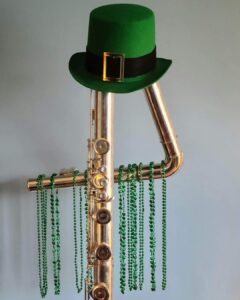CAFE is best remembered for its outstanding musicianship, playing a wide variety of musical genres, and of course the 10-foot long contrabass flute. This is the first of four articles that explore this distinctive member of the flute family. Thanks to soundversemusic.com for sharing this enlightening information.
Introduction to the Contrabass Flute
 Definition and Description:
Definition and Description:
The Contrabass flute is a member of the flute family, known for its deep and resonant sound. It is the largest and lowest-pitched instrument in the flute family, with a rich and distinct timbre.
The instrument gets its name from its size and pitch, as it is significantly larger than the standard C-flute and produces notes an octave lower. The Contrabass flute is a transposing instrument, typically pitched in C, one octave below the concert flute.
History and Development:
The history of the Contrabass flute can be traced back to the late 20th century when it was developed as an extension of the traditional flute family. The instrument was created to fulfill the need for a lower-pitched flute capable of producing deep, resonant tones.
The first prototypes of the Contrabass flute were developed by various flute makers and musicians, experimenting with different designs and dimensions to achieve the desired sound.
Importance and Role in Music:
The Contrabass flute plays a crucial role in expanding the tonal range and versatility of the flute family. Its deep and powerful sound adds a unique color and richness to musical compositions.
It is particularly valued in contemporary and experimental music genres, where composers explore the expressive potential of low-pitched instruments. The Contrabass flute also serves as a valuable addition to flute ensembles and orchestras, providing a strong foundation in the lower register and enhancing the overall sonic palette.
Physical Characteristics of the Contrabass Flute
 Size and Dimensions:
Size and Dimensions:
The Contrabass flute is an impressively large instrument, measuring around 8 to 9 feet (2.4 to 2.7 meters) in length. Its extended length allows it to produce low frequencies and deep tones. The instrument features a curved head joint and a straight body, with a foot joint that extends downwards. The overall design and shape of the Contrabass flute contribute to its unique sound production capabilities.
Materials and Construction:
Contrabass flutes are typically constructed from a variety of materials, including metals such as silver, nickel silver, or gold. The choice of material can affect the instrument’s tone quality and overall resonance.
The head joint and body of the flute are usually made of the same material, ensuring consistency in sound production. The construction of a Contrabass flute requires precision and careful attention to detail, as the large size and complex keyword demand a high level of craftsmanship.
Keywork and Mechanism:
The Contrabass flute features an intricate keywork system to facilitate precise fingering and control over the instrument. The keys are meticulously designed and positioned to accommodate the player’s hand size and provide ergonomic comfort during playing.
Due to the instrument’s size, the Contrabass flute requires unique keyword mechanisms to ensure smooth and efficient operation. The keyword system includes trill keys, octave keys, and other mechanisms necessary for executing advanced techniques and achieving accurate intonation.
Sound Production and Range
Sound Generation:
 The Contrabass flute produces sound through the vibration of air within its cylindrical tube. When a player blows air across the embouchure hole, the air column inside the flute begins to vibrate, creating sound waves.
The Contrabass flute produces sound through the vibration of air within its cylindrical tube. When a player blows air across the embouchure hole, the air column inside the flute begins to vibrate, creating sound waves.
The length and size of the flute’s tube determine the pitch produced. The Contrabass flute’s larger size and longer tube result in a deeper, richer tone compared to other flutes.
Range and Transposition:
The Contrabass flute has an impressive range that extends below the range of most other flutes. It is capable of producing pitches as low as C2, which is two octaves below middle C on the piano. This extended range allows the Contrabass flute to explore the lower registers of the musical spectrum, adding depth and richness to musical compositions.
In terms of transposition, the Contrabass flute is typically written at concert pitch, meaning that the notes written on the staff correspond directly to the sounding pitch. Unlike some transposing instruments, such as the B-flat clarinet or the alto saxo

phone, the Contrabass flute does not require the player to mentally transpose the written music.
Timbre and Tone Quality:
The timbre and tone quality of the Contrabass flute are distinctive and unique. Due to its larger size and longer tube, the Contrabass flute produces a deep and resonant sound. The lower frequencies generated by the instrument result in a warm and velvety tone that can evoke a sense of richness and depth in musical compositions.
The timbre of the Contrabass flute can be described as mellow, dark, and haunting. It possesses a certain “weight” in its sound that adds depth to ensemble performances and solo passages. The unique timbre of the Contrabass flute makes it a valuable addition to various musical genres, including classical, contemporary, and experimental music.
Part two of this series will cover embouchure, fingerings, breath control, and musical applications.




